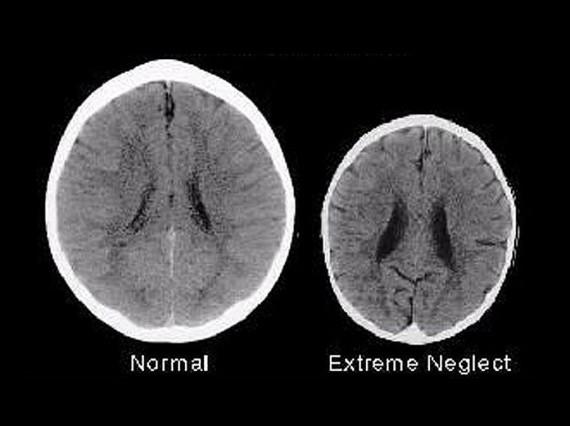We have mentioned before that 80 percent of human brain development occurs in the first three years of life. It is critical that babies and toddlers develop in a safe, trusting, and healthy co-regulated environment.
When a child experiences trauma the body increases its level of cortisol. This occurs in the lower part of the brain which controls our basic functions including our fright or flight mechanism. Since young babies and toddlers don’t have the ability to fight or flight their bodies/minds tend to freeze. It is this state which hampers and sometimes stops the upper part of the brain to think reasonably, to learn to trust, and to regulate emotions across a variety of environments. The longer the freeze state occurs the less likely the child continues on a healthy developmental trajectory, both physically and emotionally.
The image above shows the brains of 2 three year old children. The brain on the left is an image of a healthy three year old brain. The brain on the right is an image of a child that experienced extreme trauma including neglect. (Read the full study here.)
Suspected maltreatment can not be taken lightly. Trauma does not always occur directly. If there is domestic violence in the home a child can be affected even if not in the same room.
Resiliency and Families
It is important to know and then create developmental and trauma-informed care systems for children who have experienced maltreatment. We know from research that some children suffer less from neglect/abuse than other children. In the past a professional’s focus went towards maladaptive outcomes. Now best practice tells us to focus on the child and family and what is working for them. It is these systems that we need to support and build on.
Indicators for resiliencies in young children are emotional regulation, behavioral competence, formation of secure attachment relationships, peer relations and academic achievement. Key to a healthy future is good parenting. The parent-child relationship is the most important protective factor. When parents do well the children will do well. This is true especially in young children. Older children may use peer support for a healthier outcome.
As professionals we need to support parent engagement as early as possible and through out the intervention process. Infant Learning Programs can support families, along with other professionals, to build a plan that will help parents learn positive parenting skills that will support both family and child development. If you have a family that needs support, with a child or children under age 3 please refer to the Early Learning Program.
More Resources for Families
Learn about how to strengthen your family through the Strengthening Families project.
Learn how loving connections in the early years last a lifetime, on the Zero to Three website.
Figure out if it’s just a phase, or a serious problem, on the KidsHealth website.





